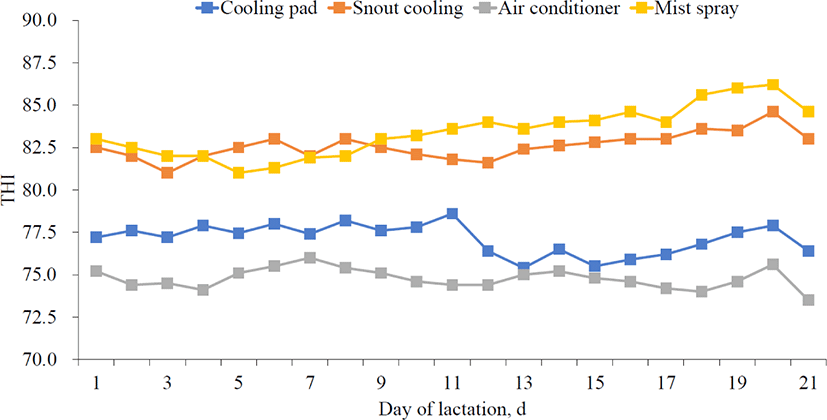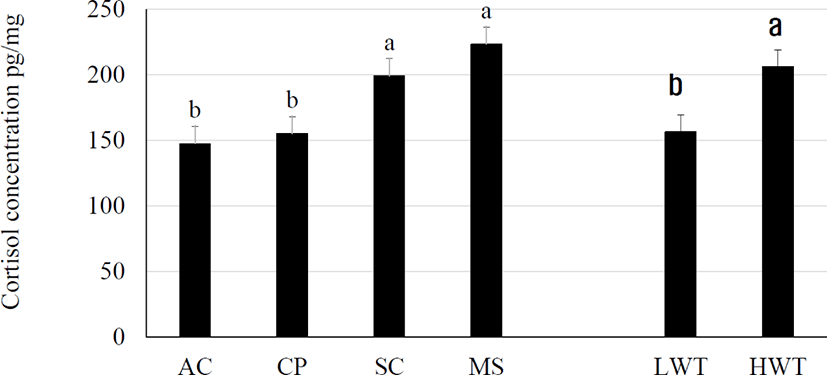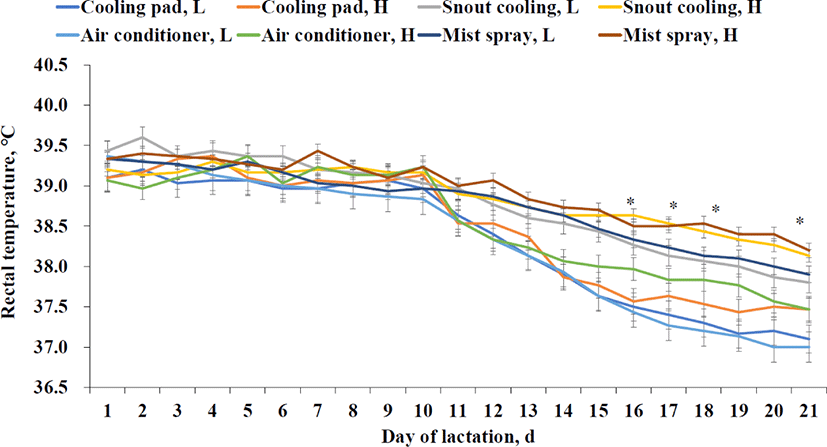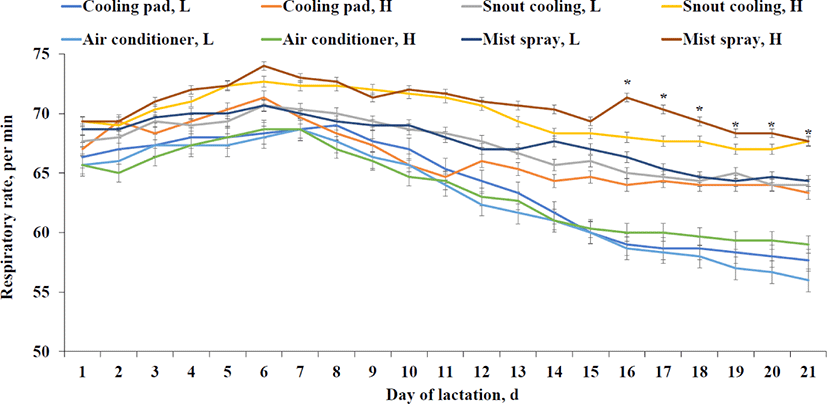INTRODUCTION
The environmental conditions play an important role in maintaining a suitable production output for animals. The temperature is rising globally, as projected by Huddart et al. [1], and therefore, heat stress (HS) is becoming a more common and serious problem. HS can hinder the performance and general welfare of animals leading to a reduction in productivity and food security [2]. The problem of HS is not only restricted to tropical areas but is extended to temperate countries as well, especially during the extreme summer months owing to the acute events of summer heatwaves [3]. Sows are extremely poor in resisting heat, not only because they lack functional sweat glands but also because they have a thick layer of subcutaneous adipose tissue that prevents radiative heat dissipation [4]. HS typically decreases the feed intake in sows [3,5], which results in bodily issues such as loss of body condition, negative energy balance, some reproductive issues related to anestrus, long weaning to estrus intervals, low farrowing rates, and poor litter size [6]. HS can also result in decreased milk production, leading to a negative impact on the overall development and weight of a piglet at the time of weaning during lactation [7]. HS plays an important role during both lactation and gestation such that the gestational HS can increase the mortality in embryos, leading to a direct impact on the farrowing rate and litter size [6]. This also extends to late gestation, wherein HS can increase the number of stillborn piglets [8] and decrease the weight in newborn piglets [9].
During hot weather, various environmental changes can aid heat loss by convection, conduction, radiation, and evaporation. On-farm HS in sows can be reduced using a variety of methods. More importantly, several cooling systems can be employed to improve the efficacy of animal welfare. However, there are limited studies that compare the effects of different cooling systems and drinking water temperatures (DWT) on the performance of sows during HS. The purpose of this study is to evaluate the effects of four different cooling systems, namely air conditioner (AC), cooling pad (CP), snout cooling (SC), and mist spray (MS), on the well-being of sows during HS. In addition to the cooling systems, we combined different DWT : low water temperature (LWT) and high water temperature (HWT), to study their effects on different parameters such as sow performance, litter performance, behavior, hair cortisol level, rectal temperature, and respiratory rate.
MATERIALS AND METHODS
The animal care and experimental protocols used in this study received approval by the Institutional Animal Care and Use Committee of Kangwon National University (Ethical code: 210503-6).
Forty-eight multiparous sows (Landrace × Yorkshire; 242.84±2.89 kg) were used to examine the outcome of various cooling facilities and two DWT in the farrowing house based on the reproductive efficiency and stress score of the sows during HS in the summer period of June to July 2021 at the Teaching and Research Farm of Kangwon National University. Only sows with successful farrowing performance were selected for the experiment, and the average litter size was 12.34 pigs/sow. The corn-soybean meal used was formulated to meet or exceed the nutrient recommendation of the National Research Council [10], and it was made available at ad libitum in powdered form as shown in Table 1. This study was conducted as a 2×4 factorial arrangement with 2 DWT (LWT; 15°C, HWT; 25 °C) and 4 cooling systems (AC, CP, SC, MS). Eight replicas of the six treatments were built, such that there was one sow per replica. The test was conducted during the lactation period (21 days upon delivery), and the animals were selected after 112 days of gestation. The floor of each stall was equipped with a cuboidal cast iron pad (56 cm × 56 cm × 5 cm; Cooling Sow System, Nooyen, Deurne, The Netherlands), which served as a surface where sows could rest while lying down. The serpentine conduits installed beneath the floor pads enabled the circulation of cool water via an appropriate channel. The water temperature in the reserve buffer tank was maintained at around 15°C using a liquid-to-liquid heat pump (Model GW62wl, Carrier, Indianapolis, IN, USA). Pumps were used to deliver 1.9 L/min of chilled water to each farrowing stall using the Tichelmann settings [11], which allows each stall to receive cool water at a corresponding temperature. The other rooms with water at 25°C had identical cast iron flooring pads. In order to ensure that the temperature of water at nipple drinkers is consistent, chilled water at 15°C was circulated repeatedly via insulated water lines to each nipple drinker. In the second method of treatment, the drinking water was neither chilled nor circulated. The treatments carried out in separate farrowing rooms, had the same delivery frame, with a length and width of 2,400 mm and 1,800 mm, respectively. Each delivery frame in the farrowing room was installed with a heating box and a lamp. The cooling systems were programmed to activate when the average temperature reached 25°C in the farrowing house.
| Item | Basal lactation diet |
|---|---|
| Calculated composition (%) | |
| ME (kcal/kg) | 3.350 |
| CP | 20.13 |
| Ca | 0.75 |
| Av. P | 0.32 |
| Lys | 1.15 |
| Met + Cys | 0.72 |
Temperature and humidity data monitoring devices (TM-305U, TENMARS, Taipei, Taiwan) were installed in each farrowing room to examine the environmental temperature during the experiment. Temperature and humidity were evaluated in terms of temperature and humidity index (THI) [12]. The mathematical formula for THI is as follows:
where T = temperature in degree (°C)
RH = relative humidity in percent (%)
After 112 days of pregnancy and weaning, the body weight and backfat thickness of sows were thoroughly examined. The backfat thickness of the sow was evaluated three times through the use of an ultrasonic measuring tool (Anyscan BF, SONG KANG GLC, Seongnam, Korea) at 6.5 cm from the 10th rib, and the mean values were determined. The average daily feed intake (ADFI) was estimated by recording the feed intake during the weaning phase and estrus relapse period. The number and weight of the piglets at farrowing and weaning of each sow were used to estimate the reproductive performance.
In our final experiment, freshly grown hair from individual animals were collected and used for the hair cortisol analysis. Before that, a part of the dorsal hair of the sows and piglets was removed at farrowing. The hair were washed three times with isopropanol, followed by drying in a vacuum dryer at 35°C, and then placed in a EML plastic tube containing steel pellets and a bead beater (tacoTMPrep, 50/60 Hz 2A, GeneReach, Taichung, Taiwan). Hair cortisols were extracted using methanol after crushing at the Biotechnology Corp. in Taiwan. A cortisol ELISA kit (ADI-900-071, Enzo Life Sciences, Farmingdale, NY, USA) was used to determine the concentration of the extracted sample [13].
During the course of this experiment, the rectal temperatures and respiratory rates of these animals were measured twice a day (11:30 and 13:00 hours) using a digital thermometer (SK-1260, SATO, Tokyo, Japan) which was inserted into the rectum and a stopwatch which helped to visually observe the abdominal motions per 1 minute in sow, respectively. The mean of these recorded values was used.
The statistical analysis system (SAS) and general linear model (GLM) was employed to analyze the data collected in the experiment at 2 × 4 factorial arrangement in a completely randomized design [14]. The Tukey test was employed for post hoc testing wherein the difference was considered to be statistically significant when the value of p was less than 0.05 (p < 0.05) in the experimental units, with the main effects for separating treatments to be AC, CP, MS, SC, as well as the LWT and the HWT with individual sow and her litter as the repeated experimental unit.
RESULTS
The temperature in the pig’s pen ranged from 24.71°C to 31.49°C at a THI of 74°C to 84°C, with AC and CP treatments showing lower scores ranging from 74.7°C to 77.0°C in comparison to the scores observed under SC and MS treatments which were higher than 80°C (Fig. 1).

A significant increase in drinking, standing, and position change behaviors was observed when sows were under SC and MS (p < 0.05) treatments in comparison to when they were under AC and CP treatment (Table 2). Lying behavior was higher in sows under AC and CP (p < 0.05) treatments than the ones under SC and MS treatments.
During lactation, the sows under AC and CP treatments showed a significantly higher ADFI (p < 0.05) than the ones under SC and MS treatments. The LWT (p < 0.05) treatment also showed an increase in ADFI as compared to the HWT treatment (Table 3).
The weaning weight of piglets under the AC and CP treatment was higher (p < 0.05) than that of piglets under SC and MS treatment (Table 4). Also, there was an increase (p < 0.05) in piglet weight during weaning in LWT as compared with the weaning weight of the ones under HWT.
Sows under SC and MS treatment had significantly higher cortisol levels (p < 0.05) than those under AC and CP treatment (Fig. 2). Cortisol levels were also higher under HWT treatment (p < 0.05) than those under LWT treatment.

During the exposure to HS, the rectal temperature and respiratory rate of the sows was recorded, as illustrated in Figs. 3 and 4. As a result, the rectal temperature and respiratory rate were found to be significantly higher under SC and MS treatment than those under AC and CP treatment (p < 0.05).


DISCUSSION
The results for THI in this experiment is in accordance with a previous study where the air cooling systems showed a reduced THI ranging from 76.1–80.1 as compared to that (THI: 79.6–82.9) under water drip [15]. A satisfactory range of THI for pigs should be less than 74 [8]. A THI value of 75–78 is considered as mild whereas a value of 79–83 is considered to be dangerous for pigs [15,16]. If the THI value is equal to or greater than 84, it is an emergency condition for pigs [17]. As per our results, the THI values under AC and CP treatment ranged from 74.7 to 77.0, which indicates that the AC and CP treatments are preferable over SC and MS in order to mitigate HS.
The increased drinking behavior of sows under SC and MS treatments supported a previous report, according to which the floor CP decreased drinking behavior in lactating sows [18]. During HS, Sows are generally known to consume more water to retrieve the water loss [11] and to reduce discomfort due to body temperature [19], as compared to the consumption under thermoneutral conditions. It is possible that an effective cooling system would minimize the drinking behavior in the sows during extreme heat. The results of this study demonstrated that the AC and CP treatments led to alleviation of drinking behavior in lactating sows.
Lactating sows under SC and MS treatment spent more time standing and changed position at intervals, but showed an opposite trend under the AC and CP treatments, wherein the sows spent more time lying. Results similar to AC and CP treatments were observed while using a CP system for lactating sows [18]. The drip cooling system proposed by Barbari et al. [20] also showed similar results of increase in lying behavior and decrease in position alteration. Lying behavior requires less energy, and the posture allows more heat exchange between the sows and the cooling system, which helps to reduce the adverse effects of HS [21]. Therefore, the use of AC and CP is beneficial because it uses the advantage of thermoregulatory behavior.
In our results, the ADFI was higher in lactating sows under AC, CP, and LWT treatments. Food consumption by lactating sows has always been a challenge during HS, presumably to alleviate the metabolic heat produced during digestion [22,23,24], which clarifies the reason for lower feed consumption in sows during HS and an increase in feed intake at a favorable thermal zone. HS can also alter milk yield by compromising dietary nutrients in the mammary gland through peripheral vasodilation [23,25]. A report by Ribeiro et al. [7] says that temperature above the thermal comfort zone negatively affects feed intake and milk production in lactating sows and the weaning weight in piglets. The improved thermal condition of sows in our study explains the reason for an increase in piglet weight at weaning under AC, CP, and LWT treatment because HS must be sufficiently reduced in sows to reach a unique potential for minimizing weight loss and improving milk production during lactation [25,26]. We agree that AC, CP, and LWT systems helped to alleviate HS in lactating sows.
The lower cortisol levels in our study are in agreement with a recent study from our laboratory, which says that the cortisol levels in the lactating sows are lower under the AC and CP treatment than under the SC and MS treatments [27]. Cortisol levels increase as the environmental temperature increases [27–29]. We hypothesized that the optimum environment for a sow is determined by the appropriate temperature provided to them under AC and CP systems, as well as under the LWT treatment. Therefore, these systems/treatments help to minimize HS thereby reducing the cortisol levels in the sows.
Rectal temperature is higher in sows particularly during lactation due to an increase in their metabolic activities that generate more heat, leading to an increase in respiratory rate [27,30,31]. The lower rectal temperature and respiratory rate observed by employing the AC, CP, and LWT systems is consistent with the report by Watanabe et al. [32], according to which a reduced rectal temperature and respiratory frequency is observed in farrowing sows while using an evaporative cooling system. A similar study by Jeon et al. [33] reported that supplying lactating sows with cold water (10°C or 15°C) decreases respiration rate and rectal temperature by about 20% and 0.8%, respectively. Therefore, we opined that the rectal temperature and respiratory rate is alleviated in pigs under HS by the AC, CP, and LWT treatments, which minimizes the overall heat production.
CONCLUSION
The use of AC and CP systems decreased drinking, standing, and position change times, and increased lying behavior as compared to the sows under SC and MS systems. The AC and CP treatments led to an increase in ADFI in sows and piglet weight at weaning in comparison to the SC and MS treatments. LWT also led to an increase in ADFI levels in sows during lactation and piglet weight at weaning. Hair cortisol levels, rectal temperature, and respiratory rates were reduced in sows under the AC, CP and LWT systems in comparison to the the SC, MS, and HWT systems. However, the LWT had no significant effect on the drinking, standing, position change times, and lying behaviors of the sows. Therefore, based on behavioral responses in sows during HS, we recommend the use of AC and CP systems for better performance of sows.
















